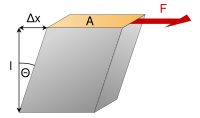
Photo from wikipedia
Isothermal and adiabatic shear moduli have been measured countless times. Adiabatic shear moduli which are generally considered to be the same as isothermal shear moduli are shown here to be… Click to show full abstract
Isothermal and adiabatic shear moduli have been measured countless times. Adiabatic shear moduli which are generally considered to be the same as isothermal shear moduli are shown here to be unstable, so they cannot exist. A constitutive law that avoids adiabatic moduli is found to apply to polycrystalline isotropic solids. The equation is a power law in the volume per unit mass time the shear modulus. The volume is in turn a function of temperature T and pressure p in the system. The adiabatic moduli are established in shear stress versus strain space using a construction from isothermal elastic shear moduli. The derivation of this law replaces adiabatic with isochoric conditions in linear elastic, sheared solids. It is widely reported that the shear thermal expansion coefficient is zero since isotropic solids do not change the shape when heated. All solids with applied shear stresses and temperature dependent shear moduli change the shape and have shear thermal expansion coefficients. The thermal expansion coefficient is coupled into the shear component of the entropy and the T dependence of the isothermal shear modulus. In a sheared solid, only the single point τ = 0, γ = 0 has no shear entropy contributions and no thermal expansion and is mechanically unstable in adiabatic constructions. The exact form of the proposed constitutive law is based on solutions from a second order differential equation based on shear contributions from the entropy.
Journal Title: Journal of Applied Physics
Year Published: 2018
Link to full text (if available)
Share on Social Media: Sign Up to like & get
recommendations!